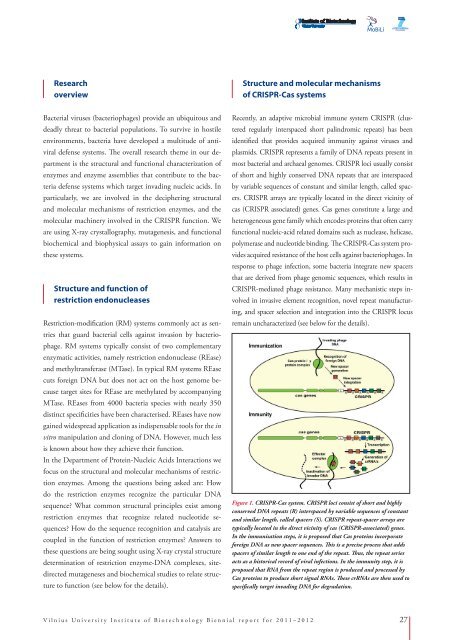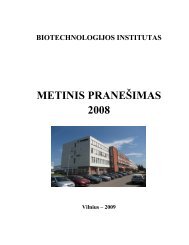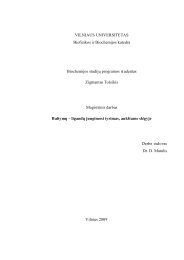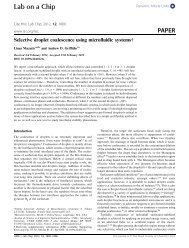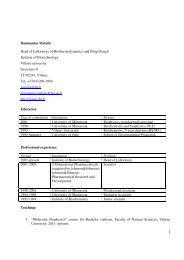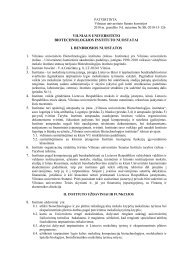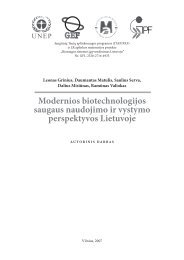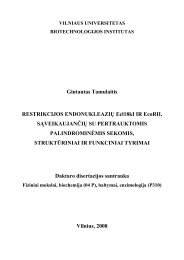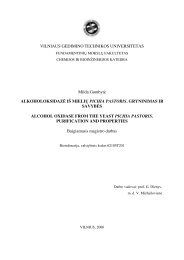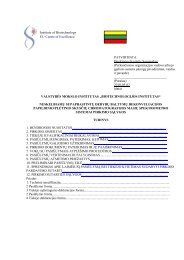Biennial Report 2011â2012
Biennial Report 2011â2012
Biennial Report 2011â2012
Create successful ePaper yourself
Turn your PDF publications into a flip-book with our unique Google optimized e-Paper software.
Research<br />
overview<br />
Structure and molecular mechanisms<br />
of CRISPR-Cas systems<br />
Bacterial viruses (bacteriophages) provide an ubiquitous and<br />
deadly threat to bacterial populations. To survive in hostile<br />
environments, bacteria have developed a multitude of antiviral<br />
defense systems. The overall research theme in our department<br />
is the structural and functional characterization of<br />
enzymes and enzyme assemblies that contribute to the bacteria<br />
defense systems which target invading nucleic acids. In<br />
particularly, we are involved in the deciphering structural<br />
and molecular mechanisms of restriction enzymes, and the<br />
molecular machinery involved in the CRISPR function. We<br />
are using X-ray crystallography, mutagenesis, and functional<br />
biochemical and biophysical assays to gain information on<br />
these systems.<br />
Structure and function of<br />
restriction endonucleases<br />
Restriction-modification (RM) systems commonly act as sentries<br />
that guard bacterial cells against invasion by bacteriophage.<br />
RM systems typically consist of two complementary<br />
enzymatic activities, namely restriction endonuclease (REase)<br />
and methyltransferase (MTase). In typical RM systems REase<br />
cuts foreign DNA but does not act on the host genome because<br />
target sites for REase are methylated by accompanying<br />
MTase. REases from 4000 bacteria species with nearly 350<br />
distinct specificities have been characterised. REases have now<br />
gained widespread application as indispensable tools for the in<br />
vitro manipulation and cloning of DNA. However, much less<br />
is known about how they achieve their function.<br />
In the Department of Protein-Nucleic Acids Interactions we<br />
focus on the structural and molecular mechanisms of restriction<br />
enzymes. Among the questions being asked are: How<br />
do the restriction enzymes recognize the particular DNA<br />
sequence What common structural principles exist among<br />
restriction enzymes that recognize related nucleotide sequences<br />
How do the sequence recognition and catalysis are<br />
coupled in the function of restriction enzymes Answers to<br />
these questions are being sought using X-ray crystal structure<br />
determination of restriction enzyme-DNA complexes, sitedirected<br />
mutageneses and biochemical studies to relate structure<br />
to function (see below for the details).<br />
Recently, an adaptive microbial immune system CRISPR (clustered<br />
regularly interspaced short palindromic repeats) has been<br />
identified that provides acquired immunity against viruses and<br />
plasmids. CRISPR represents a family of DNA repeats present in<br />
most bacterial and archaeal genomes. CRISPR loci usually consist<br />
of short and highly conserved DNA repeats that are interspaced<br />
by variable sequences of constant and similar length, called spacers.<br />
CRISPR arrays are typically located in the direct vicinity of<br />
cas (CRISPR associated) genes. Cas genes constitute a large and<br />
heterogeneous gene family which encodes proteins that often carry<br />
functional nucleic-acid related domains such as nuclease, helicase,<br />
polymerase and nucleotide binding. The CRISPR-Cas system provides<br />
acquired resistance of the host cells against bacteriophages. In<br />
response to phage infection, some bacteria integrate new spacers<br />
that are derived from phage genomic sequences, which results in<br />
CRISPR-mediated phage resistance. Many mechanistic steps involved<br />
in invasive element recognition, novel repeat manufacturing,<br />
and spacer selection and integration into the CRISPR locus<br />
remain uncharacterized (see below for the details).<br />
Figure 1. CRISPR-Cas system. CRISPR loci consist of short and highly<br />
conserved DNA repeats (R) interspaced by variable sequences of constant<br />
and similar length, called spacers (S). CRISPR repeat-spacer arrays are<br />
typically located in the direct vicinity of cas (CRISPR-associated) genes.<br />
In the immunisation steps, it is proposed that Cas proteins incorporate<br />
foreign DNA as new spacer sequences. This is a precise process that adds<br />
spacers of similar length to one end of the repeat. Thus, the repeat series<br />
acts as a historical record of viral infections. In the immunity step, it is<br />
proposed that RNA from the repeat region is produced and processed by<br />
Cas proteins to produce short signal RNAs. These crRNAs are then used to<br />
specifically target invading DNA for degradation.<br />
Vilnius University Institute of Biotechnology <strong>Biennial</strong> report for 2011–2012 27


